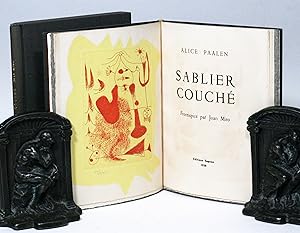joan miró alice paalen (1 resultados)
Tipo de artículo
- Todo tipo de artículos
- Libros (1)
- Revistas y publicaciones
- Cómics
- Partituras
- Arte, grabados y pósters
- Fotografías
- Mapas
-
Manuscritos y
coleccionismo de papel
Condición
- Todo
- Nuevos
- Antiguos o usados
Encuadernación
- Todo
- Tapa dura
- Tapa blanda
Más atributos
- Primera edición
- Firmado
- Sobrecubierta
- Con imágenes del vendedor
- Sin impresión bajo demanda
Ubicación del vendedor
Valoración de los vendedores
-
Sablier Couché (The Reclining Hourglass)
Publicado por Éditions Sagesse, Paris, 1938
Librería: Manhattan Rare Book Company, ABAA, ILAB, New York, NY, Estados Unidos de America
Original o primera edición Ejemplar firmado
Deluxe artist's binding. Condición: Fine. Limited edition. MARCEL DUCHAMP'S COPY, WARMLY INSCRIBED TO HIM BY ALICE PAALEN. ALSO WITH ORIGINAL FRONTISPIECE ETCHING SIGNED BY JOAN MIRÓ. BOUND BY LEGENDARY FRENCH BOOKBINDER MONIQUE MATHIEU. Signed limited edition, number 23 of only 75 copies, signed by Paalen on the limitation page (in addition to the signed inscription). On Alice Paalen: In a poem dedicated to her lover Pablo Picasso, the poet and visual artist Alice Paalen wrote, "I've been living in a map on the wall. I think I am at the crossroads of the wind. I converse with it." Bicultural, bisexual, and wildly independent, she was referred to as a shapeshifter who defied categorization. Born Alice Marie Yvonne Philppot in 1904 in eastern France, she moved to Paris with her family in 1920 and delighted in the bohemian scene. By 1934 she had married Austrian artist Wolfgang Paalen and been introduced to Paul Éluard, André Breton, Joan Miró and Pablo Picasso. In 1935 Alice had a brief love affair with Picasso, which ended when her husband threatened to kill himself. In 1936 André Breton officially invited Alice and Wolfgang to join the surrealist group, the same year that Alice became the first woman to have work published by Breton's renowned Editions Surréalistes. Alice had a far-ranging imagination and fully embraced the surrealist movement, modeling for Man Ray (in some of the hats that she created with Elsa Schiaparelli) and working closely with André Breton, Paul Éluard, Yves Tanguy, Max Ernst, Joan Miró, and Roland and Valentine Penrose (who later became her lover). When Breton opened the doors to his Galerie Gradiva in 1937 he included Alice in the dedication of his gallery and continued to be her champion throughout her career. Alice Paalen's second collection of poetry, Sablier Couché (The Reclining Hourglass), is considered one of her most important literary works. The "reclining" hourglass was meant to represent the female body shape as both a vessel and a timepiece. This signed limited edition is a collection of six poems and includes an original red etching frontispiece by Joan Miró on cut and mounted yellow paper, signed and numbered by the artist. Miró, a close friend of Alice and Wolfgang Paalen, created this illustration specifically for Sablier Couché. Sablier Couché was published in 1938 by Editions Sagesse and the poems in this collection are known for their dreamlike quality and Alice's use of nature, animals, and mythology. It's likely an autobiographical piece with Paalen as the narrator who suffers from abandonment, distress and mistreatment by her male and female lovers. In fact, it is believed that she revealed her bisexual tendencies in print for the first time in this collection. Paalen's inscription to Duchamp: Inscribed by Paalen on the front free endpaper: à Marcel Duchamp avec l'admiration et la profonde sympathie d' Alice Paalen" ["To Marcel Duchamp with admiration and deep companionship from Alice Paalen"]. She also inscribed an excerpt from one of her poems by hand at the bottom of the same page: Coupe les pieds du cheval pour qu'il se ressemble. Coupe les ponts pour mieux sauter." [Cut off the horse's feet so that it stays in one place. Cut out the bridges, to better leap ahead."]. In the year of publication (1938), Duchamp and Wolfgang Paalen worked with Breton and Éluard to arrange the central room of the Exposition Internationale du Surréalisme in Paris, thus strengthening the friendship between Duchamp and the Paalens. The binder, Monique Mathieu: Bound by arguably the foremost binder of her generation, Monique Mathieu, with her initials and the date (1966) stamped in gilt. Mathieu (born in 1927), specialized in binding books by contemporary poets and illustrated by prominent artists. This copy of Sablier Couché is spectacularly bound in smooth slate calf with brown patterned leather in relief on front and rear boards, with suede pastedowns and decorative endpapers. Housed in suede-lined chemise and slipcase. With original wrappers bound-in. S.


